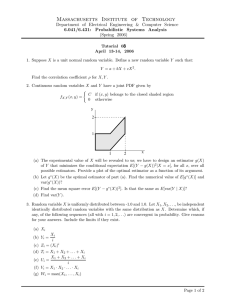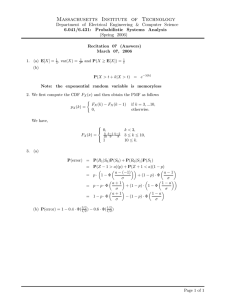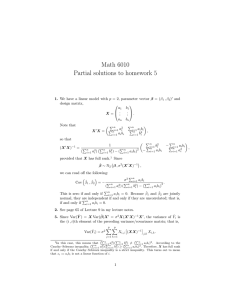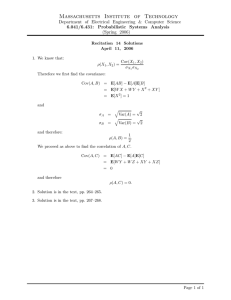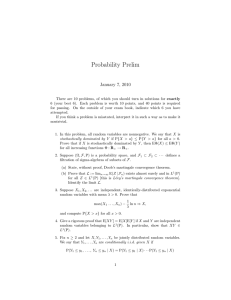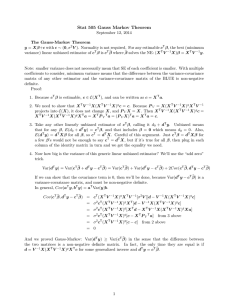Massachusetts Institute of Technology
advertisement
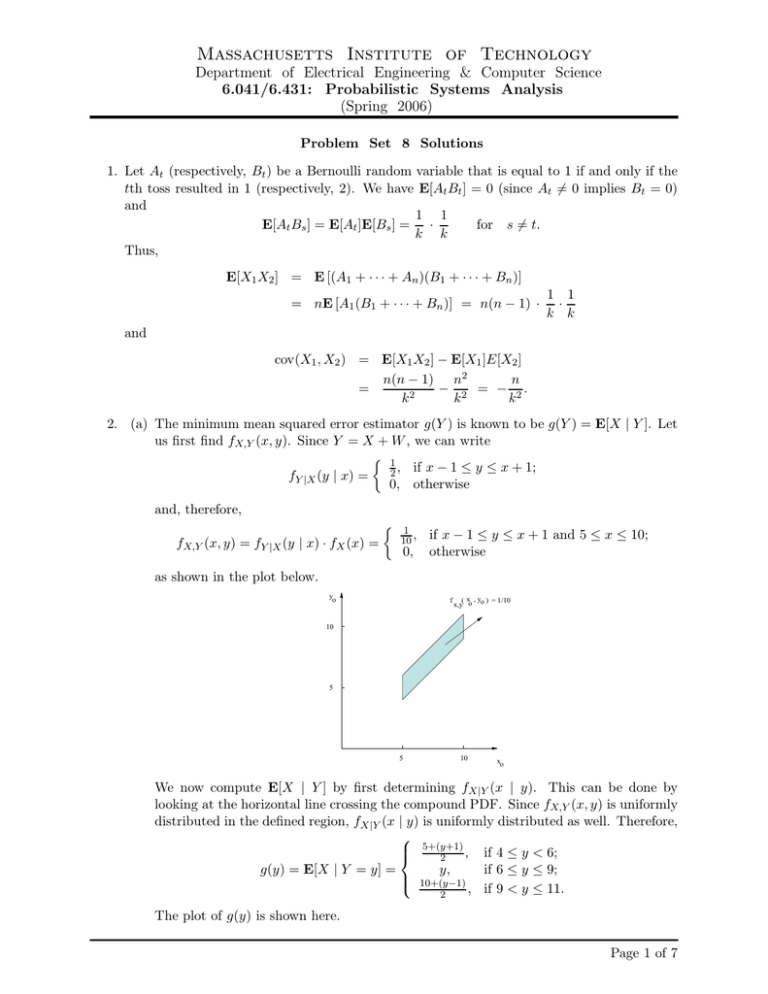
Massachusetts Institute of Technology
Department of Electrical Engineering & Computer Science
6.041/6.431: Probabilistic Systems Analysis
(Spring 2006)
Problem Set 8 Solutions
1. Let At (respectively, Bt ) be a Bernoulli random variable that is equal to 1 if and only if the
� 0 implies Bt = 0)
tth toss resulted in 1 (respectively, 2). We have E[At Bt ] = 0 (since At =
and
1 1
for s =
� t.
E[At Bs ] = E[At ]E[Bs ] = ·
k k
Thus,
E[X1 X2 ] = E [(A1 + · · · + An )(B1 + · · · + Bn )]
= nE [A1 (B1 + · · · + Bn )] = n(n − 1) ·
1 1
·
k k
and
cov(X1 , X2 ) = E[X1 X2 ] − E[X1 ]E[X2 ]
n
n(n − 1) n2
− 2 = − 2.
=
2
k
k
k
2. (a) The minimum mean squared error estimator g(Y ) is known to be g(Y ) = E[X | Y ]. Let
us first find fX,Y (x, y). Since Y = X + W , we can write
1
2 , if x − 1 ≤ y ≤ x + 1;
fY |X (y | x) =
0, otherwise
and, therefore,
fX,Y (x, y) = fY |X (y | x) · fX (x) =
1
10 ,
0,
if x − 1 ≤ y ≤ x + 1 and 5 ≤ x ≤ 10;
otherwise
as shown in the plot below.
yo
f
( x , y ) = 1/10
x,y o o
10
5
5
10
xo
We now compute E[X | Y ] by first determining fX |Y (x | y). This can be done by
looking at the horizontal line crossing the compound PDF. Since fX,Y (x, y) is uniformly
distributed in the defined region, fX |Y (x | y) is uniformly distributed as well. Therefore,
5+(y+1)
, if 4 ≤ y < 6;
2
g(y) = E[X | Y = y] =
y,
if 6 ≤ y ≤ 9;
10+(y−1) , if 9 < y ≤ 11.
2
The plot of g(y) is shown here.
Page 1 of 7
Massachusetts Institute of Technology
Department of Electrical Engineering & Computer Science
6.041/6.431: Probabilistic Systems Analysis
(Spring 2006)
11
10
9
g (yo )
8
7
6
5
4
4
5
6
7
yo
8
10
9
11
(b) The linear least squares estimator has the form
gL (Y ) = E[X] +
cov(X, Y )
(Y − E[Y ]),
σY2
where cov(X, Y )
= E[(X − E[X])(Y − E[Y ])]. We compute E[X] = 7.5, E[Y ] = E[X] +
2 = (10 − 5)2 /12 = 25/12, σ 2 = (1 − (−1))2 /12 = 4/12 and, using the
E[W ] = 7.5, σX
W
2 + σ 2 = 29/12. Furthermore,
fact that X and W are independent, σY2 = σX
W
cov(X, Y ) = E[(X − E[X])(Y − E[Y ])]
= E[(X − E[X])(X − E[X] + W − E[W ])]
= E[(X − E[X])(X − E[X])] + E[(X − E[X])(W − E[W ])]
2
2
= σX
+ E[(X − E[X])]E[(W − E[W ])] = σX
= 25/12.
Note that we use the fact that (X − E[X]) and (W − E[W ]) are independent and
E[(X − E[X])] = 0 = E[(W − E[W ])]. Therefore,
25
(Y − 7.5).
29
The linear estimator gL (Y ) is compared with g(Y ) in the following figure. Note that
g(Y ) is piecewise linear in this problem.
gL (Y ) = 7.5 +
11
10
g (yo ) , gL (yo )
9
8
7
6
5
Linear
predictor
4
4
5
6
7
yo
8
9
10
11
Page 2 of 7
Massachusetts Institute of Technology
Department of Electrical Engineering & Computer Science
6.041/6.431: Probabilistic Systems Analysis
(Spring 2006)
3. (a) The Chebyshev inequality yields P(|X − 7| ≥ 3) ≤
mative/useless bound P(4 < X < 10) ≥ 0.
9
32
= 1, which implies the uninfor-
(b) We will show that P(4 < X < 10) can be as small as 0 and can be arbitrarily close to 1.
Consider a random variable that equals 4 with probability 1/2, and 10 with probability
1/2. This random variable has mean 7 and variance 9, and P(4 < X < 10) = 0.
Therefore, the lower bound from part (a) is the best possible.
Let us now fix a small positive number ǫ and another positive number c, and consider a
discrete random variable X with PMF
0.5 − ǫ, if x = 4 + ǫ;
0.5 − ǫ, if x = 10 − ǫ;
pX (x) =
ǫ,
if x = 7 − c;
ǫ,
if x = 7 + c.
This random variable has a mean of 7. Its variance is
(0.5 − ǫ)(3 − ǫ)2 + (0.5 − ǫ)(3 − ǫ)2 + 2ǫc2
and can be made equal to 9 by suitably choosing c. For this random variable, we have
P(4 < X < 10) = 1 − 2ǫ, which can be made arbitrarily close to 1.
On the other hand, this probability can not be made equal to 1. Indeed, if this probability
were equal to 1, then we would have |X − 7| ≤ 3, which would imply that the variance
in less than 9.
4. Consider a random variable X with PMF
if x = µ − c;
p,
pX (x) =
p,
if x = µ + c;
1 − 2p, if x = µ.
The mean of X is µ, and the variance of X is 2pc2 . To make the variance equal σ 2 , set
σ2
p = 2c
2 . For this random variable, we have
P(|X − µ| ≥ c) = 2p =
σ2
,
c2
and therefore the Chebyshev inequality is tight.
5. Note that n is deterministic and H is a random variable.
(a) Use X1 , X2 , . . . to denote the (random) measured heights.
X1 + X2 + · · · + Xn
n
E[X1 + X2 + · · · + Xn ]
nE[X]
E[H] =
=
= h
n r
n
p
n var(X)
(var of sum of independent r.v.s is sum of vars)
var(H) =
σH =
n2
1.5
= √
n
H =
Page 3 of 7
Massachusetts Institute of Technology
Department of Electrical Engineering & Computer Science
6.041/6.431: Probabilistic Systems Analysis
(Spring 2006)
(b) We solve
1.5
√
n
< 0.01 for n to obtain n > 22500.
(c) Apply the Chebyshev inequality to H with E[H] and var(H) from part (a):
P(|H − h| ≥ t) ≤
σ 2
H
t
P(|H − h| < t) ≥ 1 −
σ 2
H
t
To be “99% sure” we require the latter probability to be at least 0.99. Thus we solve
1−
with t = 0.05 and σH =
1.5
√
n
σ 2
H
t
≥ 0.99
to obtain
n≥
1.5
0.05
2
1
= 90000.
0.01
(d) The variance of a random variable increases as its distribution becomes more spread
out. In particular, if a random variable is known to be limited to a particular closed
interval, the variance is maximized by having 0.5 probability of taking on each endpoint
value. In this problem, random variable X has an unknown distribution over [0, 3]. The
variance of X cannot be more than the variance of a random variable that equals 0 with
probability 0.5 and 3 with probability 0.5. This translates to the standard deviation not
exceeding 1.5.
In fact, this argument can be made more rigorous as follows.
First, we have
3
9
var(X) ≤ E[(X − )2 ] = E[X 2 ] − 3E[X] +
2
4
since E[(X − a)2 ] is minimized when a is the mean (i.e., the mean is the least-squared
estimator).
Second, we also have
0 ≤ E[X(3 − X)] = E[X] − E[X 2 ]
since the variable has support in [0, 3]. Adding the above two inequalities, we have
var(X) ≤
9
4
or equivalently, σX ≤ 23 .
6. First, let’s calculate the expectation and the variance for Yn , Tn , and An .
Yn = (0.5)n Xn
Tn = Y1 + Y2 + · · · + Yn
1
Tn
An =
n
Page 4 of 7
Massachusetts Institute of Technology
Department of Electrical Engineering & Computer Science
6.041/6.431: Probabilistic Systems Analysis
(Spring 2006)
1
E [Yn ] = E ( 12 )n Xn = ( )n E [Xn ] = E [X] ( 21 )n = 2( 12 )n
2
var (Yn ) = var ( 21 )n Xn = ( 21 )2n var (Xn ) = var (X) ( 12 )2n = 9( 41 )2n
E [Tn ] = E [Y1 + Y2 + · · · + Yn ] = E[Y1 ] + E[Y2 ] + · · · + E[Yn ]
X
n 0.5(1 − 0.5n )
= 2
( 12 )i = 2
= 2 1 − 12
1 − 0.5
n
X
var (Tn ) = var (Y1 + Y2 + · · · + Yn ) =
( 41 )i var (Xi )
i=1
1
4
1 n
4
1
4
!
n 1−
= 3 1 − 14
1−
n 1
1
2
1 − 21
E [An ] = E
Tn = E [Tn ] =
n
n
n
n 2
1
1
3
1
var (An ) = var
Tn =
var (Tn ) = 2 1 −
n
n
n
4
= 9
(a) Yes. Yn converges to 0 in probability. As n becomes very large, the expected value of
Yn approaches 0 and the variance of Yn approaches 0. So, by the Chebychev Inequality,
Yn converges to 0 in probability.
(b) No. Assume that Tn converges in probability to some value a. We also know that:
Tn = Y1 + (Y2 + Y3 + .....Yn )
= Y1 + ((0.5)2 X2 + (0.5)3 X3 + · · · + (0.5)n Xn )
1
= Y1 + (0.5X2 + (0.5)2 X3 + · · · + (0.5)n−1 Xn ).
2
Notice that 0.5X2 + (0.5)2 X3 + · · · + (0.5)n−1 Xn converges to the same limit as Tn when
n goes to infinity. If Tn is to converge to a, Y1 must converge to a/2. But this is clearly
false, which presents a contradiction in our original assumption.
(c) Yes. An converges to 0 in probability. As n becomes very large, the expected value of
An approaches 0, and the variance of An approaches 0. So, by the Chebychev Inequality,
An converges to 0 in probability. You could also show this by noting that the An s are
i.i.d. with finite mean and variance and using the WLLN.
7. (a) Suppose Y1 , Y2 , . . . converges to a in mean of order p. This means that E[|Yn − a|p ] → 0,
so to prove convergence in probability we should upper bound P(|Yn − a| ≥ ǫ) by a
multiple of E[|Yn − a|p ]. This connection is provided by the Markov inequality.
Let ǫ > 0 and note the bound
E[|Yn − a|p ]
,
ǫp
where the first step is a manipulation that does not change the event under consideration
and the second step is the Markov inequality applied to the random variable |Yn − a|p .
Since the inequality above holds for every n,
P(|Yn − a| ≥ ǫ) = P(|Yn − a|p ≥ ǫp ) ≤
E[|Yn − a|p ]
= 0.
n→∞
αp
lim P(|Yn − a| ≥ α) ≤ lim
n→∞
Page 5 of 7
Massachusetts Institute of Technology
Department of Electrical Engineering & Computer Science
6.041/6.431: Probabilistic Systems Analysis
(Spring 2006)
Hence, we have that {Yn } converges in probability to a.
(b) Consider the sequence {Yn }∞
n=1 of random variables where
0, with probability1 − n1 ;
Yn =
n, with probability n1
Note that {Yn } converges in probability to 0, but E[|Yn − 0|1 ] = E[Yn |] = 1 for all n.
Hence, {Yn } converges in probability to 0 but not in mean of order 1.
G1† . (a) E[ˆ
µ] = E[ n1 (X1 + · · · + Xn )] = n1 (E[X1 ] + · · · + E[Xn ]) = n1 · nE[X] = µ.
Hence, µ̂ is an an unbiased estimator for the true mean µ.
(b)
#
n
n
1X
1
1X
2
(Xi − µ) =
E[(Xi − µ)2 ] = · nσ 2 = σ 2 .
E[σ̂ ] = E
n
n
n
"
2
i=1
i=1
Therefore σ̂ 2 (which uses the true mean) is unbiased estimator for σ 2 .
(c)
n
n
X
X
µ − µ)]2
(Xi − µ)
ˆ 2 =
[Xi − µ − (ˆ
i=1
i=1
=
n
X
i=1
µ − µ)2 − 2(Xi − µ)(ˆ
µ − µ)
(Xi − µ)2 + (ˆ
n
n
X
X
2
2
µ − µ) − 2(ˆ
µ − µ)
(Xi − µ)
=
(Xi − µ) + n(ˆ
i=1
i=1
n
X
µ − µ)2 − 2(ˆ
µ − µ)n(ˆ
µ − µ)
=
(Xi − µ)2 + n(ˆ
i=1
n
X
=
(Xi − µ)2 − n(µ̂ − µ)2
i=1
(d)
#
#
" n
" n
X
X
µ − µ)2 ]
= E
(Xi − µ)2 − nE[(ˆ
ˆ 2
E
(Xi − µ)
i=1
i=1
!2
n
X
1
= nσ 2 − nE 2
Xi − µ
n
i=1
n X
n
X
1
(Xi − µ)(Xj − µ)
= nσ 2 − E
n
i=1 j=1
" n
#
X
1
= nσ 2 − E
(Xi − µ)2
n
i=1
= (n − 1)σ
2
Page 6 of 7
Massachusetts Institute of Technology
Department of Electrical Engineering & Computer Science
6.041/6.431: Probabilistic Systems Analysis
(Spring 2006)
where we used the fact that for i =
� j, E[(Xi − µ)(Xj − µ)] = 0; and for i = j, it is is
equal to σ 2 .
(e) From part (d),
n
ˆˆ 2 =
σ
1 X
(Xi − µ)
ˆ 2
n−1
i=1
is an unbiased estimator for the variance.
(f)
1
var(µ̂) = var( (X1 + · · · + Xn ))
n
1
=
(var(X1 ) + · · · + var(Xn ))
n2
1
=
· nσ 2
n2
σ2
.
=
n
Thus, var(ˆ
µ) goes to zero asymptotically. Furthermore, we saw that E[ˆ
µ] = µ. Simple
application of Chebyshev inequality shows that µ̂ converges in probability to µ (the true
mean) as the sample size increases.
(g) Not yet typeset.
Page 7 of 7

